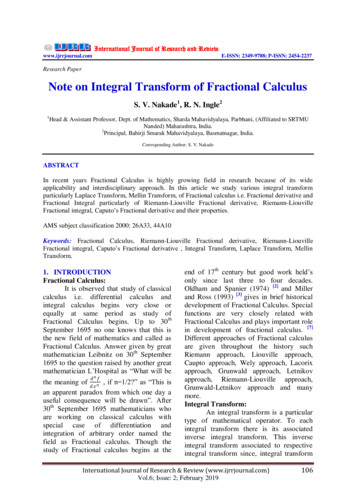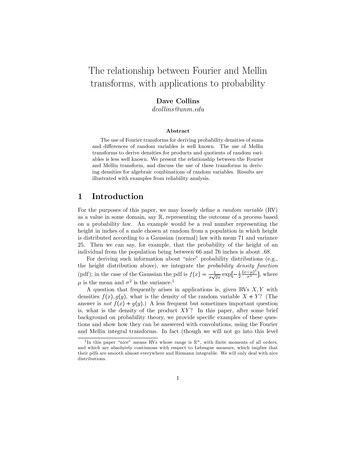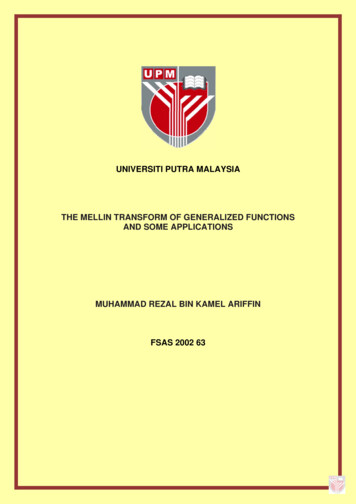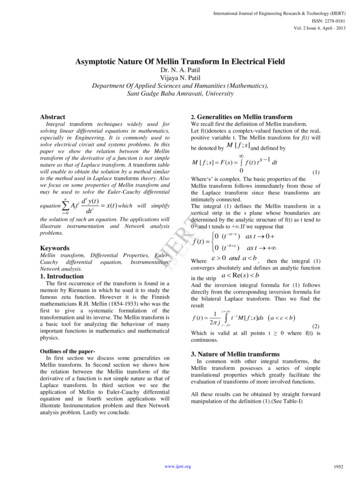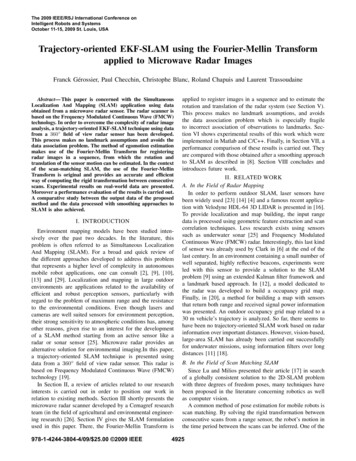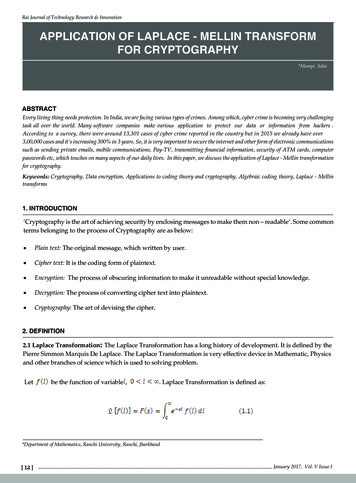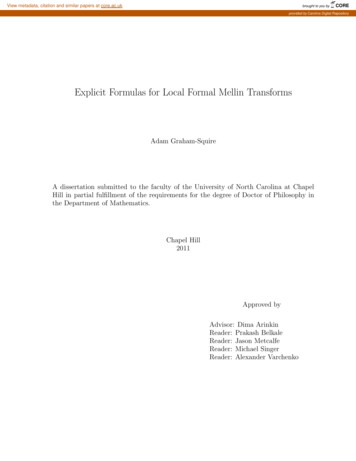
Transcription
View metadata, citation and similar papers at core.ac.ukbrought to you byCOREprovided by Carolina Digital RepositoryExplicit Formulas for Local Formal Mellin TransformsAdam Graham-SquireA dissertation submitted to the faculty of the University of North Carolina at ChapelHill in partial fulfillment of the requirements for the degree of Doctor of Philosophy inthe Department of Mathematics.Chapel Hill2011Approved byAdvisor: Dima ArinkinReader: Prakash BelkaleReader: Jason MetcalfeReader: Michael SingerReader: Alexander Varchenko
AbstractADAM GRAHAM-SQUIRE: Explicit Formulas for Local Formal Mellin Transforms(Under the direction of Dima Arinkin)Much recent work has been done on the local Fourier transforms for connections on thepunctured formal disk. Specifically, the local Fourier transforms have been introduced,shown to induce certain equivalences of categories, and explicit formulas have been foundto calculate them. Our goal is to corroborate recent results for calculation of the localFourier transforms and then extend our methods to a similar situation, the local Mellintransforms.This dissertation is divided into three main parts. In the first part we prove explicitformulas for calculation of the local Fourier transforms. These formulas have recentlybeen proved by others, and we reproduce their results using different techniques. Theother two parts of the dissertation are given over to applying those same techniques to thelocal Mellin transforms for connections on the punctured formal disk. In the second part,we introduce the local Mellin transforms and show that they induce equivalences betweencertain categories of vector spaces with connection and vector spaces with invertibledifference operators. In the third part we find formulas for explicit calculation of thelocal Mellin transforms in the same spirit as the results for the local Fourier transforms.ii
AcknowledgementsI would first like to thank the mathematics faculty at the University of North Carolinaat Chapel Hill. In particular, the members of my committee have been quite helpful.I am especially grateful to my advisor Dima Arinkin for his flexibility, many helpfuldiscussions, and consistent encouragement of my graduate work. Jason Metcalfe andMichael Singer have both taken extra time out of their busy schedules to talk with meabout my research, for which I am very thankful. Special thanks also go to PrakashBelkale and Alexander Varchenko for their many clarifying questions.I am eternally grateful to everyone in my family for their support and encouragementthroughout my graduate school career. Most notably, without Anne’s patience, encouragement, and funding this dissertation would not have happened. Dominic has kept mefocused on the important things in life, and without Jane’s help I would (literally) nothave had the time to finish. Lastly, I would like to thank my fellow graduate studentsfor their help over the past five years. Specifically, my officemates Parul, Ellen, Brandynand Robby have been a wonderful support network and great people with whom I couldtalk math, and Brian’s help with my computer questions has saved me countless hours.iii
Table of ContentsIntroduction . . . . . . . . . . . . . . . . . . . . . . . . . . . . . . . . . . . . . . . . . . . . . . . . . . . . . . . . . . . . . . . . . . . . . .10.1. Historical context . . . . . . . . . . . . . . . . . . . . . . . . . . . . . . . . . . . . . . . . . . . . . . . . . . . . . .10.2. Local Fourier transform . . . . . . . . . . . . . . . . . . . . . . . . . . . . . . . . . . . . . . . . . . . . . . . .40.3. Local Mellin transform . . . . . . . . . . . . . . . . . . . . . . . . . . . . . . . . . . . . . . . . . . . . . . . . .50.4. Overview of dissertation . . . . . . . . . . . . . . . . . . . . . . . . . . . . . . . . . . . . . . . . . . . . . . .7Chapter1. Background . . . . . . . . . . . . . . . . . . . . . . . . . . . . . . . . . . . . . . . . . . . . . . . . . . . . . . . . . . . . . . . . . .81.1. Connections on the formal disk . . . . . . . . . . . . . . . . . . . . . . . . . . . . . . . . . . . . . . . . .81.2. Difference operators on the formal disk . . . . . . . . . . . . . . . . . . . . . . . . . . . . . . . . . 111.3. Notation . . . . . . . . . . . . . . . . . . . . . . . . . . . . . . . . . . . . . . . . . . . . . . . . . . . . . . . . . . . . . . . 161.4. The norm and order of an operator . . . . . . . . . . . . . . . . . . . . . . . . . . . . . . . . . . . . . 161.5. Operator-root Lemma . . . . . . . . . . . . . . . . . . . . . . . . . . . . . . . . . . . . . . . . . . . . . . . . . . 222. Explicit calculations for local Fourier transforms . . . . . . . . . . . . . . . . . . . . . . . . . . . . . 252.1. Local Fourier transforms . . . . . . . . . . . . . . . . . . . . . . . . . . . . . . . . . . . . . . . . . . . . . . . 262.2. Statement of theorems . . . . . . . . . . . . . . . . . . . . . . . . . . . . . . . . . . . . . . . . . . . . . . . . . 272.3. Proof of theorems . . . . . . . . . . . . . . . . . . . . . . . . . . . . . . . . . . . . . . . . . . . . . . . . . . . . . . 292.4. Comparison with previous results . . . . . . . . . . . . . . . . . . . . . . . . . . . . . . . . . . . . . . 343. Introduction of local Mellin transforms . . . . . . . . . . . . . . . . . . . . . . . . . . . . . . . . . . . . . . . 373.1. Definitions and previous results . . . . . . . . . . . . . . . . . . . . . . . . . . . . . . . . . . . . . . . . 373.2. Lemmas . . . . . . . . . . . . . . . . . . . . . . . . . . . . . . . . . . . . . . . . . . . . . . . . . . . . . . . . . . . . . . . 393.3. Definition of local Mellin transforms . . . . . . . . . . . . . . . . . . . . . . . . . . . . . . . . . . . . 40iv
3.4. Definition of local inverse Mellin transforms . . . . . . . . . . . . . . . . . . . . . . . . . . . . 453.5. Equivalence of categories . . . . . . . . . . . . . . . . . . . . . . . . . . . . . . . . . . . . . . . . . . . . . . . 494. Explicit formulas for local Mellin transforms . . . . . . . . . . . . . . . . . . . . . . . . . . . . . . . . . 554.1. Statement of theorems for local Mellin transforms . . . . . . . . . . . . . . . . . . . . . . 554.2. Statement of theorems for local inverse Mellin transforms . . . . . . . . . . . . . . 584.3. Proof of theorems . . . . . . . . . . . . . . . . . . . . . . . . . . . . . . . . . . . . . . . . . . . . . . . . . . . . . . 58References . . . . . . . . . . . . . . . . . . . . . . . . . . . . . . . . . . . . . . . . . . . . . . . . . . . . . . . . . . . . . . . . . . . . . . . . 67v
IntroductionThe main goal of this dissertation is the definition and calculation of the local Mellintransforms on a punctured formal disk. In order to understand the local Mellin transforms, it is necessary to understand recent work that has been done on an analogousconstruction, that of the local Fourier transforms for connections on the formal punctured disk. In this introduction, we wish to put our work on the local Mellin transformsin its proper context by explaining the genesis and the recent history of research done onthe local Fourier transforms. In section 0.1 we give a brief historical background to thelocal Fourier transforms. We describe in section 0.2 recent work that has been done onthe local Fourier transforms, and in section 0.3 we explain the theoretical origin of thelocal Mellin transforms and what we wish to prove about them. Section 0.4 provides athumbnail sketch of the main body of the dissertation.0.1. Historical context0.1.1. Classical Fourier transform. In order to understand the origin of the localFourier transform, our narrative begins with the ‘classical’ Fourier transform. For asuitable function f , the Fourier transform of f is given byfˆ(ξ) Zf (x)e ixξ dx.In particular, the Fourier transform has two main properties: it is invertible (and theinverse is of virtually the same form) and the following equalities hold d ˆf dξdixfd ξ fˆ idf.dx
The equalities above can be useful in the following manner: one can apply the Fouriertransform to an ordinary differential equation and then solve the resulting, hopefullyeasier, differential equation. In a related form, one can also consider the Fourier transformas an action on a differential operator, which is described below.0.1.2. Fourier transform on the Weyl algebra. Consider the ring of ordinary differential operators with polynomial coefficients, also known as the Weyl algebra. Wewrite W for the Weyl algebra, and thus we have DdE dnW C[z] pn (z) · · · p0 (z) pi (z) C[z]dzdzwith the convention thatdzdzd z dz 1. In this context, the Fourier transform is theautomorphism F T : W W defined on its generators by z 7 ddzandddz7 z. Whatwe refer to as the local Fourier transforms can be derived from the Fourier transform onthe Weyl algebra as we explain in the following subsection. We note that the descriptionbelow is only for motivation; it is a framework and is not written in a completely rigorousmanner. Definitions of the local Fourier transforms are given a precise construction inthe body of the dissertation.0.1.3. Local Fourier transform. For every element p of the Weyl algebra, one can “diD Edvide through by the leading coefficient” to get a monic element of the algebra C(z) dz,ddzwith coefficients that are rational functions in z. This allowsD Edone to associate to every element of W a unique element of C(z) dz. By writing a higherthat is, a polynomial inorder differential operator as a system of linear differential operators, one can associateD Edto each element of C(z) dza linear matrix differential operator with entries in C(z)(for details of this process, see [vdPS03, Section 1.2]). If one is interested in lookinglocally at a linear matrix differential operator with entries in C(z), one can choose alocal coordinate and consider the corresponding linear matrix differential operator withentries that are formal Laurent series, which we denote as C((z)). Thus to each p W2
and x C one can associate Px , a linear matrix differential operator with entries inC((z)).In a similar fashion, to the original differential operator p W, one can apply theFourier transform to get F T (p) p̂ W. One can then apply the process describedabove to p̂ in order to get a corresponding linear matrix differential operator with entriesin C((z)), call it P̂y . The local Fourier transform (LF T ) is the map that takes theequivalence class of Px to the equivalence class of P̂y and completes the diagram givenbelow:ndpn (z) dz · · · p0 (z)FT/dp̂m (z) dzm · · · p̂0 (z) d ndz d mdz · · · q0 (z) · · · q̂0 (z) ddz A ddzddz L/ LF T Â / ddz L̂/ d npn (z) dz · · · p0 (z) with pi C[z] (respectively p̂i ) and D E D E ddqi C(z) (respectively q̂i ). We also have A Mn C(z) dz, Â Mm C(z) dz, D E D E ddL Mn C((z)) dz, L̂ Mm C((z)) dz, and the equivalence for the matrixHere p corresponds todifferential operators refers to gauge equivalence. It should not be clear at this pointthat the map LF T even exists or is well-defined. We describe in the next section therecent work that has been done to put the local Fourier transform on a rigorous footing.Remark. The local Fourier transform has different flavors depending on the point oflocalization, hence in this dissertation we generally refer to local Fourier transforms.Both conventions for terminology are found in the literature. In general, the study oflocal Fourier transforms need not be restricted to the complex numbers. Thus in laterchapters we work over an arbitrary algebraically closed field of characteristic zero.3
0.2. Local Fourier transform0.2.1. Local Fourier for -adic sheaves. The seminal paper regarding the localFourier transform is [Lau87] by G. Laumon in 1987. To study the local behavior ofthe Fourier transform, Laumon introduced the geometric stationary phase principle andestablished the local Fourier transformations. The transformations as given in [Lau87]are defined in terms of cohomological functors and thus are rarely computable, but in[Lau87, 2.6.3], Laumon and Malgrange give conjectural formulas of local Fourier transforms for a class of Q̄ -sheaves, which were later proved (with a slight adjustment) by L.Fu in [Fu07].0.2.2. Local Fourier transforms for meromorphic connections over Laurentseries fields. In the case of formal differential systems defined over a field of characteristic zero, the analogues of the local Fourier transforms defined by Laumon were givenindependently in 2004 by S. Bloch and H. Esnault in [BE04] and by R. Garcia Lopezin [GL04]. The methods used in [BE04] and [GL04] are different, though. The construction of the local Fourier transforms in [GL04] follows the microlocal techniques ofB. Malgrange. In [Mal81], Malgrange gives a microanalytic construction for the localFourier transforms F (0, ) and F ( ,0) , which Garcia Lopez then extends in [GL04]. In[BE04], rigorous definitions for the local Fourier transforms for meromorphic connectionsover Laurent series fields are given and it is shown that they have properties analogousto the local -adic Fourier transforms. However, neither [BE04] nor [GL04] give explicitformulas for how to calculate the local Fourier transforms.0.2.3. Explicit formulas for local Fourier transforms. Calculation of the localFourier transforms was proved independently in 2007 by C. Sabbah in [Sab07] and J.Fang in [Fan07]. The calculations were of a quite different flavor, with Sabbah takinga geometric approach and Fang’s proof more algebraic in nature. An important technical tool used in the calculation is the formal reduction of differential operators to acanonical form. This work goes back to H.L. Turritin [Tur55] and A. Levelt [Lev75],4
with more recent expositions given by B. Malgrange [Mal91], D.G. Babbitt and V.S.Varadarajan [BV85], as well as M. van der Put and M. Singer [vdPS03]. In [BBE,Section 5.9], Beilinson, Bloch and Esnault present the canonical form in a way that isuseful to our construction, and in [Var96] Varadarajan gives a helpful historical overviewand summary of research on linear meromorphic differential equations.0.2.4. Another viewpoint. In 2008 D. Arinkin’s paper [Ari] gave another frameworkfor the local Fourier transforms. His construction is beneficial because it makes relatingthe singularities of a holonomic D-module and its global Fourier transform virtually tautological. Such a relation is one of the central properties of the local Fourier transforms.Arinkin goes on to give explicit calculation of the Katz-Radon transform in [Ari] as well.In Chapter 2, we use the same methods of [Ari] to give another proof of the calculations done in [Fan07] and [Sab07]. Arinkin’s techniques are particularly advantageousbecause they generalize nicely to making calculations for local Mellin transforms.0.3. Local Mellin transformThe general motivation for the local Mellin transform is virtually identical to themotivation given above for the local Fourier transform, so we do not repeat it in fulldetail here. We mention only that the ‘classical’ Mellin transform can be stated asfollows: for an appropriate f the Mellin transform of f is given byf (η) Z xη 1 f (x)dx0and one can check that the following identities hold: d η f x dxfg) Φf (xfwhere Φ is the difference operator taking f (η) to f (η 1). These identities can be used todefine the local Mellin transform in the same way that properties of the Fourier transformare used to define the local Fourier transform. As in the case of the Fourier transform,5
the local Mellin transform has different ‘flavors’ depending on the point of singularity, sowe refer to them as local Mellin transforms.There is one large distinction between the local Fourier transforms and the localMellin transforms, however. Whereas the local Fourier transforms take a linear matrixdifferential operator to another linear matrix differential operator, the local Mellin transforms take a linear matrix differential operator to a linear matrix difference operator. In[BE04] and [GL04], clear connections are drawn between the local and global Fouriertransforms. Such connections can be made for the Mellin transform as well, but are notincluded in this dissertation as our focus is purely on the local construction.The global Mellin transform for connections on a punctured formal disk is givenby Laumon in [Lau96], but since that time little work has been done on the Mellintransform in this area. In [Ari, Section 2.5], Arinkin remarks that it would be interestingto apply his methods to other integral transforms such as the Mellin transform. Chapters3 and 4 of this dissertation are the answer to that query. In Chapter 3, we define thelocal Mellin transforms in an analogous manner to the definitions of the local Fouriertransforms which were given in [Ari], [BE04], and [GL04]. In particular, we mimicthe framework given in [Ari] in order to define the local Mellin transforms, as Arinkin’sconstruction lends itself most easily to calculation. In Chapter 3 we also show thatthe local Mellin transforms induce equivalences for certain categories of vector spaceswith connection and vector spaces with difference operators. Such equivalences could,in principle, reduce questions about difference operators to questions about (relativelymore-studied) connections, although we do not do such an analysis in this work. InChapter 4 we give explicit formulas for the local Mellin transforms in the spirit of thosegiven in Chapter 2 (as well as [Fan07] and [Sab07]) for the local Fourier transform.Again an important tool for the calculation will be the formal reduction of differentialoperators described above, as well as the formal reduction of linear difference operatorsgiven by C. Praagman in [Pra83] as well as G. Chen and A. Fahim in [CF98]. There6
are considerable parallels between difference operators and connections, and we refer thereader to [vdPS97] for more details.0.4. Overview of dissertationA brief description of the remainder of the dissertation is as follows: In Chapter 1 wegive a synopsis of the most important notation, conventions, results and definitions thatwe will use. Chapter 2 is devoted to proving explicit formulas for calculating the localFourier transforms for connections on a formal punctured disk (e. g. Theorem 2.2.1),reproducing the results of [Fan07] and [Sab07] with a different method of proof. InChapter 3 we introduce the local Mellin transforms (e. g. Definition 3.3.1) and theirinverses and describe some of their properties, then we give explicit formulas for the localMellin transforms in Chapter 4 (e. g. Theorem 4.1.1).7
CHAPTER 1BackgroundIn this chapter we give the definitions, notation, and results most pertinent to thedissertation. We also describe recent research related to our topic so as to put our workin its proper context in a rigorous manner. In section 1.1 we discuss connections on thepunctured formal disk and in section 1.2 we give an analogous construction for differenceoperators on the punctured formal disk. Section 1.3 details some useful notation we willuse throughout the dissertation and section 1.4 has information about the norm andorder of an operator. We end with section 1.5, where we prove a lemma that will beimportant for our calculations in Chapters 2 and 4.We fix a ground field k, which is assumed to be algebraically closed of characteristiczero.1.1. Connections on the formal diskOne of the primary objects we work with are differential operators, or connections,on the formal disk. Specifically, the local Fourier transform takes a connection on theformal disk and outputs a connection on the formal disk. The local Mellin transforminputs a connection and produces a difference operator on the formal disk, which wedefine in section 1.2. We write K k((z)) for the field of formal Laurent series.1.1.1. Definitions.Definition 1.1.1. Let V be a finite-dimensional vector space over K. A connection onV is a k-linear operator : V V satisfying the Leibniz identity: (f v) f (v) dfvdz
for all f K and v V . Equivalently, we can write that [ , f ] : f f f 0 . Achoice of basis in V gives an isomorphism V ' K n ; we can then write asddz A, whereA A(z) gln (K) is the matrix of with respect to this basis. We sometimes refer totheddz(respectively A) as the differential part (respectively linear part) of the operator .Definition 1.1.2. We write C for the category of vector spaces with connections overK. Its objects are pairs (V, ), where V is a finite-dimensional K-vector space and : V V is a connection. Morphisms between (V1 , 1 ) and (V2 , 2 ) are K-linear mapsφ : V1 V2 that are horizontal in the sense that φ 1 2 φ.1.1.2. Properties of connections. We summarize below some well-known propertiesof connections on the formal disk. The results go back to Turritin [Tur55] and Levelt[Lev75]; more recent references include [BV85], [BBE, Sections 5.9 and 5.10], [Mal91],and [vdPS97].Let q be a positive integer and consider the field Kq k((z 1/q )). Note that Kq is theunique extension of K of degree q. For every f Kq , we define an object Ef C by Ef Ef,q dKq , z 1 fdz .In terms of the isomorphism class of an object Ef , the reduction procedures of [Tur55]and [Lev75] imply that we need only consider f in the quotient(1.1)k((z1/q . 11/q1/q))z k[[z ]] Zqwhere k[[z]] denotes formal power series.Let Rq (we write Rq (z) when we wish to emphasize the local coordinate) be the setof orbits for the action of the Galois group Gal(Kq /K) on the quotient. Explicitly, theGalois group is identified with the group of degree q roots of unity η k; the action onf Rq is by f (z 1/q ) 7 f (ηz 1/q ). Finally, denote by Rq Rq the set of f Rq thatcannot be represented by elements of Kr for any 0 r q.9
Remark. Rq can alternatively be described as the locus of Rq where Gal(Kq /K) actsfreely.Definition 1.1.3. We define the direct sum and tensor product on the category Cas follows:(V1 , 1 ) (V2 , 2 ) : (V1 V2 , ),where (v1 v2 ) 1 (v1 ) (v2 ).(V1 , 1 ) (V2 , 2 ) : (V1 V2 , ),where (v1 v2 ) 1 (v1 ) v2 v1 2 (v2 ).Proposition 1.1.4.(1) The isomorphism class of Ef depends only on the orbit of the image of f in Rq .(2) Ef is irreducible if and only if the image of f in Rq belongs to Rq . As q and fvary, we obtain a complete list of isomorphism classes of irreducible objects ofC.(3) Every E C can be written asE'M(Efi ,qi Jmi ),idwhere the Ef,q are irreducible, Jm (K m , dz z 1 Nm ), and Nm is the nilpotentJordan block of size m.Proofs of the proposition are either prevalent in the literature (cf. [BBE], [Mal91],[vdPS97]) or straightforward and thus are omitted here. Analogous properties of difference operators are given in the following section, and we give proofs at that point.Remark. We often refer to the objects (Ef Jm ) C as indecomposable objects in C.10
1.2. Difference operators on the formal diskVector spaces with difference operator and vector spaces with connection are definedin a similar fashion.1.2.1. Definitions.Definition 1.2.1. Let V be a finite-dimensional vector space over K k((θ)). Adifference operator on V is a k-linear operator Φ : V V satisfyingΦ(f v) ϕ(f )Φ(v)for all f K, v V , with ϕ : K n K n as the k-automorphism defined below. Achoice of basis in V gives an isomorphism V ' K n ; we can then write Φ as Aϕ, whereA A(θ) gln (K) is the matrix of Φ with respect to this basis, and for v(θ) K n wehave ϕ(v(θ)) vθ1 θ v X!( 1)i 1 θi.i 1We follow the convention of [Pra83, Section 1] to define ϕ over the extension Kq k((θ1/q )). Thus for all q Z , ϕ extends to a k-automorphism of Kqn defined by" #! X 1/q ϕ v(θ1/q ) v θ1/qθi.ii 0Definition 1.2.2. We write N for the category of vector spaces with invertible differenceoperator over K. Its objects are pairs (V, Φ), where V is a finite-dimensional K-vectorspace and Φ : V V is an invertible difference operator. Morphisms between (V1 , Φ1 )and (V2 , Φ2 ) are K-linear maps φ : V1 V2 such that φΦ1 Φ2 φ.1.2.2. Properties of difference operators. In [CF98] and [Pra83], a canonical formfor difference operators is constructed. We give an equivalent construction in the theorembelow, which is a restatement of [Pra83, Theorem 8 and Corollary 9] with differentnotation so as to better fit our situation.11
Theorem 1.2.3 ([Pra83], Theorem 8 and Corollary 9). Let Φ : V V be an invertibledifference operator.Then there exists a finite (Galois) extension L of K and a basis of L K V such thatΦ is expressed as a diagonal block matrix. Each block is of the form g λ 1 . . Fg θ . . .with g Kq , λ 1q Z, g a0 θλ · · · aq θλ 1 , a0 6 0, and aq defined up to a shift bya0Zθλ 1 .qThe matrix is unique modulo the order of the blocks.Remark. The Fg are the indecomposable components for the matrix of Φ.Theorem 1.2.3 allows us to describe the category N in a fashion similar to our description of the category C. For every g Kq , we define an object Dg N by Dg Dg,q : Kq , gϕ .The canonical form given in Theorem 1.2.3 implies that we need only consider g in thefollowing quotient of the multiplicative group k((θ1/q )) :(1.2)Kq . 11 (1/q)1/q1 Zθ θk[[θ ]] .qLet Sq be the set of orbits for the action of the Galois group Gal(Kq /K) on the quotientgiven in (1.2). Denote by Sq Sq the set of g Sq that cannot be represented byelements of Kr for any 0 r q. As before, Sq can be thought of as the locus whereGal(Kq /K) acts freely.Definition 1.2.4. We define the direct sum and tensor product on the category Nas follows:(V1 , Φ1 ) (V2 , Φ2 ) : (V1 V2 , Φ ),12
where Φ (v1 v2 ) Φ1 (v1 ) Φ(v2 ).(V1 , Φ1 ) (V2 , Φ2 ) : (V1 V2 , Φ ),where Φ (v1 v2 ) Φ1 (v1 ) Φ2 (v2 ).Proposition 1.2.5.(1) The isomorphism class of Dg depends only on the orbit of the image of g in Sq .(2) Dg is irreducible if and only if the image of g in Sq belongs to Sq . As q and gvary, we obtain a complete list of isomorphism classes of irreducible objects ofN.(3) Every D N can be written asD'M(Dgi ,qi Tmi ),iwhere the Dg,q are irreducible, Tm (K m , Um ϕ), and Um Im θNm where Nmis the nilpotent Jordan block of size m.Proof.(1) For a given object Dg0 , Theorem 1.2.3 implies that Dg0 ' Dg whereg 0 g as elements of the quotient given in (1.2). All that is left is to show that anaction of the Galois group does not affect the isomorphism class. Let µ k suchthat µq 1. Consider the morphism φ : Kq Kq defined by φ(θ1/q ) µθ1/q .Then φ is a K-linear map that is easily seen to be an isomorphism sendingDg(θ1/q ) to Dg(µθ1/q ) .(2) Note that an object D (V, Φ) is irreducible if the only Φ-invariant subspacesof V are 0 and V . A proof of the first statement is as follows. To prove theforward direction, let Dg N such that g / Sq . This implies that g Kr forsome 0 r q, and it follows that r divides q, so Kr is a proper subspace ofKq fixed by the action of g. Thus Dg is reducible.For the reverse direction, assume that Dg is reducible. Then there existsa proper K-subspace V 0 of Kq which is invariant under Φ. After extension of13
scalars from K to Kq , Φ is diagonalizable with the diagonal entries of its matrixbeing σi (g) g(µi z 1/q ) for all 0 i q, where µ is a primitive q th root of unity.This implies that the diagonal entries of Φ V 0 Kq : V 0 Kq V 0 Kq will beof the form σi (g) for some i. However, the Galois group Gal(Kq /K) acts on Kq ,so if the operator Φ V 0 Kq has one σi (g) as a diagonal entry, it must have σi (g)for all i. Thus V 0 being a proper subspace implies that σi (g) σj (g) for some0 i 6 j q, which only occurs if g Kr for some 0 r q.To prove the second statement, we need to show that if D (V, Φ) Nis irreducible then D ' Dg,q for some g and q such that the image of g lies inSq . Consider D in canonical form: we extend to V Kq (assume we choosethe minimum such q) and take an eigenvector v of the matrix of Φ V Kq witheigenvalue g. The Galois group Gal(Kq /K) acts on V Kq , and we let W bethe span of the orbit of v in Gal(Kq /K). Thus W is invariant with respect tothe action of the Galois group, so it represents a subspace of V . Moreover, theeigenvalues of the matrix of Φ V Kq are of the form σi (g), so W is invariant withrespect to the action of Φ V Kq as well. Since D is irreducible, W must be all ofV and D ' Dg,q . Note that the image of g will be in Sq because we chose thesmallest possible q.(3) The statement of Theorem 1.2.3 makes it clear that D can be written as adirect sum of indecomposable operators, thus it suffices to prove that for anindecomposable D ' (Kqm , Fg ϕ) we have D ' Dg Tm for some g and m.Specifically, we show that Kqm , Fg ϕ ' (Kq , gϕ) (K m , (Im θNm )ϕ) .14
From the reduction procedure outlined in [Pra83][Lemma 4] we find that g Kqm , θ1 λ g .m m. ϕ ' Kq , gθ ϕ Kq , g(Im θNm )ϕ ,. . . .so all that remains is to show that Kqm , g(Im θNm )ϕ ' (Kq , gϕ) (K m , (Im θNm )ϕ) .To give such an isomorphism, we need an invertible map φ : Kqm (Kq K m )Pvi ei Kqmsuch that φ 1 (gϕ (Im θNm )ϕ)φ g(Im θNm )ϕ. Let v where vi Kq and {ei } is the appropriate basis. Let e0 and {e00i } be the basesfor Kq and K m respectively. Then we define the map φ : Kqm (Kq K m ) onits basis vectors by φ(ei ) e0 e00i . Note that φ is clearly invertible. We cannow show thatφ 1 (gϕ (Im θNm )ϕ)φmX!vi ei φ 1 (gϕ (Im θNm )ϕ)mXi 1!vi e0 e00ii 1 φ 1mX! gϕ(vi )e0 (e00i θe00i 1 )i 1 φ 1 gmX!ϕ(vi )e0 e00i ϕ(vi )θe0 e00i 1i 1 gmX!ϕ(vi )ei ϕ(vi )θei 1i 1 gmX![ϕ(vi ) θϕ(vi 1 )] eii 1 g(Im θNm )ϕmX!vi ei.i 1Note that in the proof above we use the common notation that em 1 v0 0.215
1.3. NotationAt times it is usef
local Mellin transforms and what we wish to prove about them. Section0.4provides a thumbnail sketch of the main body of the dissertation. 0.1. Historical context 0.1.1. Classical Fourier transform. In order to understand the origin of the local Fourier transform, our narrative begins with
